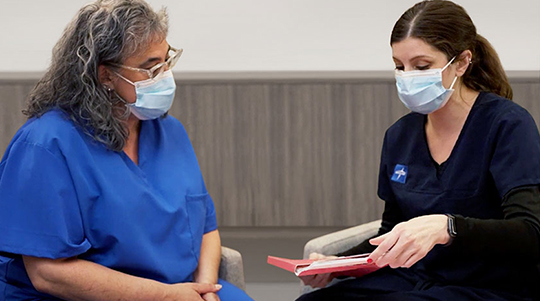Improve chronic wound outcomes: Standardize care across the continuum
5 building blocks to drive better communication and collaboration.

A patient with a chronic wound has been discharged from the hospital to a wound care center. Now the patient is ready to be transferred to a long-term care facility. Although the post-acute care (PAC) team doesn’t have all the relevant information for this patient, they admit him and begin care. What’s missing? A plan for long-term care, goals for recovering and other essentials, possibly even basic patient history.
The above scenario isn’t that unusual. Unfortunately, it’s a situation that makes it harder for post-acute caregivers to provide whole-person care. It’s especially harder amid an increasing number of higher-acuity patients being transferred from acute to post-acute care facilities or sent home despite their need for more specialized healthcare services.
“There’s not enough communication from the hospital to the post-acute or home care setting.”

—Cristine Ray
BSN, RN, CWON, Medline Clinical Nurse Specialist
Ensure smart collaboration
“It depends on the hospital or health system, but there’s not enough communication from the hospital to the post-acute or home care setting,” says Cristine Ray, BSN, RN, CWON, Medline Clinical Nurse Specialist. “Even in an era of electronic charting, that information isn’t always passed on.”
Without proper information sharing and collaboration between acute and post-acute care, it’s difficult to ensure seamless care and positive outcomes for chronic wound patients. It’s important to remember that patients with chronic wounds typically have comorbidities and complex care needs.
Health systems that foster a culture of patient-centered care and encourage post-acute care coordination can reap a number of benefits, including:
- Improved quality of care and patient safety
- Improved wound outcomes
- Reduction in unnecessary or duplicative tests or services
- Fewer hospital readmissions and ED visits
- Lower overall healthcare costs
Bridge acute and post-acute care for chronic wound patients with a strategy that’s based on standardized protocols and best practices. It starts with facilitating communication and collaboration among all caregivers involved. Read on to learn how to support tighter clinical cooperation.
5 key building blocks for a successful cross-continuum strategy
1. Work together as equals. As the saying goes, “There’s no ‘I’ in team.” Building a solid foundation for collaboration means working together. Critical elements of your plan include integrated information systems, evidence-based clinical pathways and standardized care plans. Use clinically relevant performance measures that align incentives in each care setting.1
2. Get everyone on the same page. Select a resource such as the “Care Coordination Tool for Transition to Long-Term and Post-Acute Care,” provided by the National Learning Consortium at HealthIT.gov. This guide details key clinical information that can be included in summary of care records when transitioning patients to a long-term care facility. Use these guidelines as a basis for creating a cross-continuum strategy or integrate them with existing transition protocols. Then, educate all clinical staff members involved in the treatment of wound care patients.
3. Take advantage of information from the post-acute setting. The post-acute care setting can often be a vast reservoir for patient information, including clinical data accumulated over the course of long-term stays. The data may also reveal details about patients’ home environments and relevant social determinants of health that can inform treatment decisions. If possible, set up a time to speak to the patients’ post-acute caregivers so you’ll learn about any clinical recommendations and comorbidities.1
4. Standardize wound care protocols across the continuum. Seek out reputable best-practice guidelines from such organizations as the Wound, Ostomy and Continence Nurses Society™ (WOCN) or the International Wound Infection Institute (IWII) that everyone across the continuum will use. Implement these and educate all staff members involved in the treatment of wound care patients.
5. Tap your vendor partner. Encourage communication between your skin health experts from acute and post-acute so that everyone across care settings utilizes the same products. Also seek agreement across the continuum on alternative products that can be used when those prescribed are not available. Finally, take advantage of supplemental resources available through your distributor to advance high-quality care, such as best-practice guidelines and customized education.
Key takeaway
It takes a village to care for patients with chronic wounds—from acute and post-acute caregivers to family members. But high-quality treatment and positive outcomes are possible when everyone across the continuum is engaged and involved, following the same protocols and processes, and utilizing the same products for each type of wound.
References:
1. Bentley, F. (2022, July 19). 4 Things Hospital Executives Need to Know About Post-Acute Care. Avalere Health. https://avalere.com/insights/4-things-hospital-executives-need-to-know-about-post-acute-care




